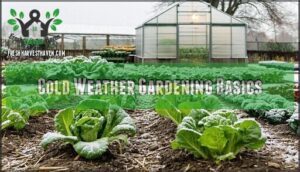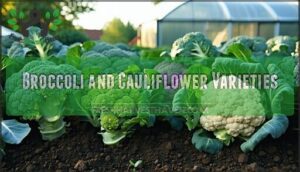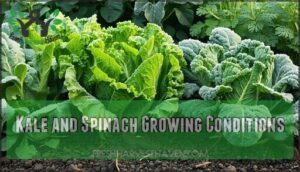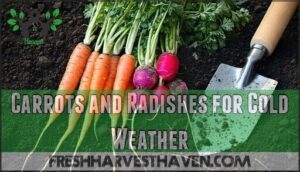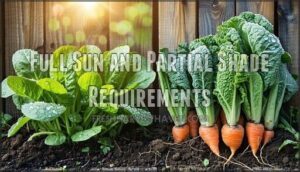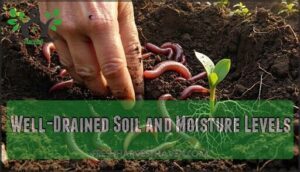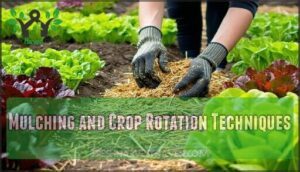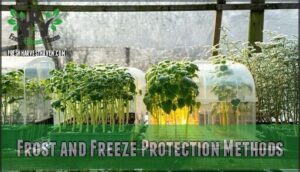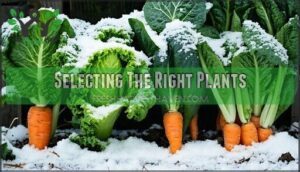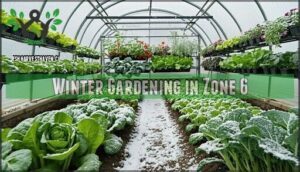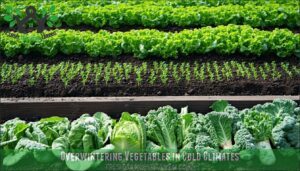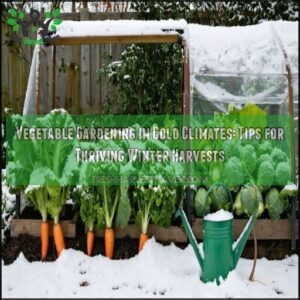This site is supported by our readers. We may earn a commission, at no cost to you, if you purchase through links.
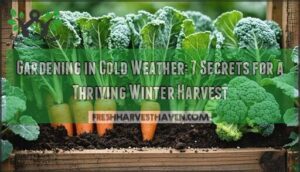 Gardening in cold weather isn’t as tough as it sounds—you’ve just got to play it smart.
Gardening in cold weather isn’t as tough as it sounds—you’ve just got to play it smart.
Focus on prepping your soil with compost to keep it healthy and well-drained because frozen dirt is no fun for plant roots.
Stick with cold-hardy champs like kale, carrots, and broccoli—they’re pretty much the superheroes of winter gardens.
Frost sneaking in? Toss on a row cover or try a cold frame to shield your plants.
And don’t forget, sunlight matters even in winter, so position your garden where it can soak up those precious rays.
Trust me, your veggies will thank you! Ready to dig deeper?
Table Of Contents
- Key Takeaways
- Cold Weather Gardening Basics
- Cold Hardy Vegetable Plants
- Growing Conditions and Care
- Frost and Freeze Protection Methods
- Selecting The Right Plants
- Frequently Asked Questions (FAQs)
- How cold is too cold for garden plants?
- How to garden in cold weather?
- What vegetables grow best in cold weather?
- Should you water garden when it’s cold?
- How cold is too cold for a garden?
- Can plants grow at 40 degrees?
- What is the lowest temperature a garden can handle?
- Can vegetable plants survive 40 degree weather?
- How to protect garden tools in winter?
- What’s the best way to store seeds?
- Conclusion
Key Takeaways
- Prep your soil with compost and mulch to keep it healthy, insulated, and well-drained during the winter months.
- Stick with cold-hardy veggies like kale, carrots, and spinach that can handle freezing temperatures and even thrive.
- Protect plants from frost with row covers, cold frames, or homemade cloches, and ensure they get 4-6 hours of sunlight daily.
- Water in the morning sparingly and avoid overwatering to prevent frozen roots while keeping your soil moist but not soggy.
Cold Weather Gardening Basics
You don’t need a green thumb to grow food when temperatures drop—just the right knowledge and a bit of preparation.
With proper soil protection, cold-hardy plant selection, and an understanding of frost patterns, you’ll be harvesting fresh veggies while your neighbors are shopping the produce aisle.
Preparing Soil for Cold Weather
Prep your soil before winter strikes to give your garden a fighting chance against the cold.
Good soil preparation acts as your garden’s cozy winter blanket, protecting plant roots and ensuring nutrient availability when spring arrives.
- Add compost and aged manure to boost nutrient retention and improve soil structure
- Create drainage improvements by adding perlite or raised beds to prevent waterlogging
- Apply winter mulching (straw or leaf mold) 2-3 inches thick to insulate soil and suppress weeds
Consider these tips for effective soil amendments to achieve effective and proper soil preparation.
Choosing The Right Plants for Cold Weather
When winter’s chill arrives, selecting cold hardy plants becomes your garden’s lifeline.
You’ll want to focus on crops that can withstand freezing temperatures and even thrive in cooler conditions.
| Plant Family | Hardiness Zone | Growth Habit |
|---|---|---|
| Brassicas | 2-9 | Upright/Leafy |
| Root Veggies | 3-10 | Below ground |
| Leafy Greens | 4-9 | Low-growing |
Visit local nurseries for cold tolerant varieties already adapted to your region’s winter dormancy patterns to ensure a thriving garden with proper care.
Understanding Frost and Freeze Warnings
When you’re tuned into frost and freeze warnings, you’ll save your precious plants from winter’s bite. Understanding these alerts helps your cold weather gardening success.
Here’s what warning terms really mean:
- Frost Advisory: 33-36°F – Light frost possible, tender plants at risk
- Freeze Warning: 28-32°F – Hard frost likely, most annuals won’t survive
- Hard Freeze Warning: Below 28°F – Severe damage to most plants
- Killing Freeze: Below 24°F – End of growing season for unprotected plants
To mitigate potential damage, consider how row covers offer protection.
Cold Hardy Vegetable Plants
You’ll be amazed at how many veggies actually prefer the cold, with kale, spinach, and carrots transforming from garden basics to winter superstars when temperatures drop.
Your winter garden doesn’t have to be a barren wasteland – these cold-hardy champions can withstand frosty conditions and even develop sweeter flavors after a light freeze, making them winter superstars.
Broccoli and Cauliflower Varieties
Looking for the best broccoli and cauliflower varieties to grow in the cold? These nutritious cold weather crops offer excellent disease resistance when you select the right cultivars.
| Variety | Climate Tolerance | Notable Features |
|---|---|---|
| Purple Magic (Broccoli) | Cold-hardy | High pest resistance |
| Early White Hybrid (Cauliflower) | Frost-tolerant | Quick maturing |
| Nutribud (Organic) | Moderate cold | Superior nutritional value |
For Louisiana gardens, try Patriot broccoli or Freedom cauliflower for dependable winter harvests.
Kale and Spinach Growing Conditions
While broccoli and cauliflower need specific care, kale and spinach are the true champions of cold weather gardening.
They’ll thrive in soil pH between 6.0-7.0, preferring slightly acidic conditions. Both vegetables need consistent watering practices but hate soggy roots.
For pest control, watch for aphids—they can’t resist these nutritious greens. Companion planting with herbs like dill or cilantro helps deter pests naturally.
These leafy superstars actually taste sweeter after a light frost!
Carrots and Radishes for Cold Weather
You’ll find carrots and radishes are perfect cold weather companions in your winter garden.
These semi-hardy root vegetables can withstand light frosts and temperatures between 28-32°F.
Plant them in deep, loose soil that’s consistently moist but never soggy.
Winter radishes mature in 8-10 weeks, while spring radishes germinate faster, making them excellent companion planting partners for pest control.
Consider zone hardiness guidelines to optimize your planting schedule.
Monitor soil temperature carefully when harvesting these nutrient-packed crops for ideal storage methods.
Growing Conditions and Care
You’ll need to pay special attention to growing conditions for your winter garden, as even cold-hardy plants have specific needs to truly thrive in chilly weather.
Your winter vegetables will thank you with bountiful harvests when you provide the right balance of sunlight, well-drained soil, and protective mulch layers to insulate their roots from winter’s icy grip.
Full Sun and Partial Shade Requirements
Now that you’ve selected your cold-hardy champions, let’s talk sunlight.
Your winter veggies need different light exposure than summer crops. Most cool weather vegetables thrive with 4-6 hours of direct sunlight daily, unlike summer plants that crave 8+ hours.
Plant positioning matters—create microclimates by using walls or fences to reflect light intensity.
Remember, shade tolerance increases as temperatures drop, so don’t worry if your growing space isn’t perfectly sunny, and consider the importance of cold-hardy champions in this context.
Well-Drained Soil and Moisture Levels
While sunlight requirements vary, your soil conditions play an equally important role in cold weather gardening success.
Well-drained soil prevents root rot when temperatures drop.
Monitor your cold-weather garden’s moisture with these techniques:
- Press your finger 1-inch deep – if it’s dry, water thoroughly
- Install raised beds to improve drainage in clay soils
- Amend soil with compost to balance moisture retention
- Water in the morning to prevent overnight freezing
- Check soil temperature before watering – below 40°F requires less
The key to successful cold-weather gardening is understanding how to manage and maintain your garden’s health, including preventing root rot and managing water properly.
Mulching and Crop Rotation Techniques
Success in your winter garden hinges on smart soil management. Apply organic mulches like straw or compost to insulate roots and maintain consistent moisture levels while suppressing weeds.
Pair this with strategic crop rotation every 3-4 years to break pest cycles naturally and optimize nutrient cycling. You’ll notice healthier plants when you rotate different plant families, allowing your soil to recover between demanding crops while building long-term soil health.
To guarantee the best growth, consider conducting regular soil tests to determine pH and nutrient levels.
Frost and Freeze Protection Methods
You’ll need to arm your garden against winter’s icy grip if you want to harvest throughout the colder months.
From simple homemade cloches to high-tech heated frames, these frost protection methods will keep your plants cozy when temperatures plummet.
Covering Plants From Frost Damage
When temperatures drop, your garden needs a cozy blanket too! Different frost blanket types can save your crops from icy damage.
For emergency frost covers, sheets, cardboard boxes, or even newspapers work in a pinch. You can find a suitable protective option for your plants.
Watering before frost helps plants retain heat overnight. Insulating plant pots with bubble wrap or mulch keeps roots toasty.
Remember, proper frost protection isn’t just about covering—it’s about creating a microclimate that shields your green friends from the cold weather bite.
Bringing Sensitive Plants Indoors
While physical covers protect your garden outside, some plants simply won’t survive freezing temperatures no matter how well you bundle them up.
Let’s talk about bringing those tender plants indoors for winter protection.
When rescuing sensitive plants from frost, consider the following steps:
- Check thoroughly for pests before bringing plants inside
- Gradually acclimate plants to indoor conditions over 1-2 weeks
- Position near south-facing windows for maximum natural light
- Maintain higher humidity with pebble trays or humidifiers.
- Use quality potting mixes that provide good drainage
Consider using an indoor plant humidifier to help regulate moisture.
Using Row Covers and Cold Frames
While indoor protection works for potted plants, your garden beds need their own winter jackets!
Row covers and cold frames are like cozy blankets for your vegetables.
Lightweight row covers offer 2-4°F protection, while heavier ones can shield plants from temperatures 6-8°F colder.
For serious winter gardening, try a cold frame with proper ventilation strategies. Hinged lids are useful for this purpose.
These season extension tools help you keep harvesting fresh veggies long after your neighbors have quit, using cold frames as a key method.
Selecting The Right Plants
You’ll need to pick the right cold-hardy plants if you don’t want your winter garden to look like a vegetable graveyard come January.
Hardy varieties like kale, spinach, and carrots can actually thrive when temperatures drop, turning your frosty garden into a surprising source of fresh produce while your neighbors’ plots lie dormant.
Choosing Heat-Tolerant and Cold-Hardy Varieties
While protecting your plants from frost is necessary, finding the right varieties can make winter gardening much easier.
Look for plants that handle both extremes, like Summerific Hibiscus that thrives in zone 9 heat yet survives zone 4 winters.
Mexican Bush Sage and Profusion salvias attract pollinators while standing up to temperature swings.
Your hardiness zone is your roadmap – use it to select cold-tolerant plants that won’t surrender when temperatures plummet.
Saving Seeds From Heirloom Vegetables
Savvy gardeners know that heirloom vegetables are treasure troves for seed saving, especially in cold climates.
Testing seed viability is vital before storing for winter.
Follow these essential steps:
- Choose self-pollinating varieties to prevent cross-pollination
- Harvest seeds only from your healthiest plants
- Dry seeds thoroughly before storage to prevent mold
- Store in airtight containers in a cool, dark place, which is crucial for maintaining seed viability and preventing the growth of mold.
Understanding Planting Zones and Sizes
Knowing your zone hardiness is like having a map to gardening success in a cold climate.
Choose cold-tolerant plants that thrive in your area’s temperatures.
Consider plant spacing and container sizes—your carrots need space to grow, not neighbors stealing sunlight!
Match root depth and mature size to your garden beds to avoid crowding.
Plant hardiness truly matters!
Frequently Asked Questions (FAQs)
How cold is too cold for garden plants?
Think of plants like houseguests—they hate overstaying in the cold.
Most garden plants struggle below 32°F.
Frost damages tender leaves, but hardy crops, like kale and spinach, can handle freezing temperatures with proper care and protection.
How to garden in cold weather?
Start planting hardy crops like kale or carrots and use cold frames, row covers, or hoop houses to shield them.
Timing’s key—get your seeds in 6-8 weeks before frost.
Trust me, it’s doable!
What vegetables grow best in cold weather?
Did you know spinach can survive temperatures as low as 20°F?
Leafy greens like kale, Swiss chard, and root veggies like carrots and turnips thrive in cold weather, giving you fresh, hearty harvests all winter!
Should you water garden when it’s cold?
Yes, water your garden even when it’s cold, but do it sparingly.
Plants need hydration to survive, but overwatering can freeze roots.
Aim for mid-mornings so water absorbs before temperatures drop overnight.
How cold is too cold for a garden?
When frost bites hard—below 28°F—most gardens call it quits.
Hardy veggies like kale or spinach can tough it out, but tender plants like tomatoes shiver to death.
Cover plants or move pots for protection!
Can plants grow at 40 degrees?
Plants can grow at 40°F, but it’s like a slow jog instead of a sprint.
Cold-tolerant crops like spinach, kale, and peas will manage fine, though growth will substantially slow in chilly soil.
What is the lowest temperature a garden can handle?
A garden can handle temps as low as 35-40°F, depending on the plants.
Hardy veggies like kale or carrots survive even frost.
Add row covers for extra warmth—your garden’s like a cozy, plant-sized sweater!
Can vegetable plants survive 40 degree weather?
Imagine plants as tough adventurers braving the wild.
Many veggies, like kale and spinach, handle 40 degrees like pros.
Just watch out—tomatoes or peppers? They’re the divas needing warmth to thrive.
How to protect garden tools in winter?
Store tools in a dry shed or garage, clean off dirt and rust, and coat metal parts with mineral oil to prevent corrosion.
Hang them up or use wall racks to protect handles from splitting.
What’s the best way to store seeds?
Keep seeds in a cool, dry spot, like an airtight jar in the fridge.
Add a silica gel packet to battle moisture.
Properly labeled envelopes avoid confusion—trust me, nobody wants mystery squash popping up!
Conclusion
In the context of gardening in cold weather, don’t let the frost nip at your progress—prep smart and stay ahead of the chill.
Healthy soil, cold-hardy veggies like kale and carrots, and a touch of frost protection go a long way.
Position your garden to soak up weak winter sunlight, and remember, tools like row covers and cold frames are your best allies.
Stay patient, adapt to your plants’ needs, and your winter garden will thrive!
- https://www.weatherapi.com/
- https://spiderfarmer.eu/blog/winter-gardening/
- https://www.searshomeservices.com/blog/lawn-and-garden-maintenance-for-fallwinter
- https://skillins.com/blogs/news/planning-your-2025-vegetable-garden-tips-for-success?srsltid=AfmBOorvSqfPwGNZLuDWQJojNSGlj2w6oVmbt_TtkA2sfizupRkuVOet
- https://homesteadingfamily.com/gardening-in-winter-cold-weather-growing-methods/

